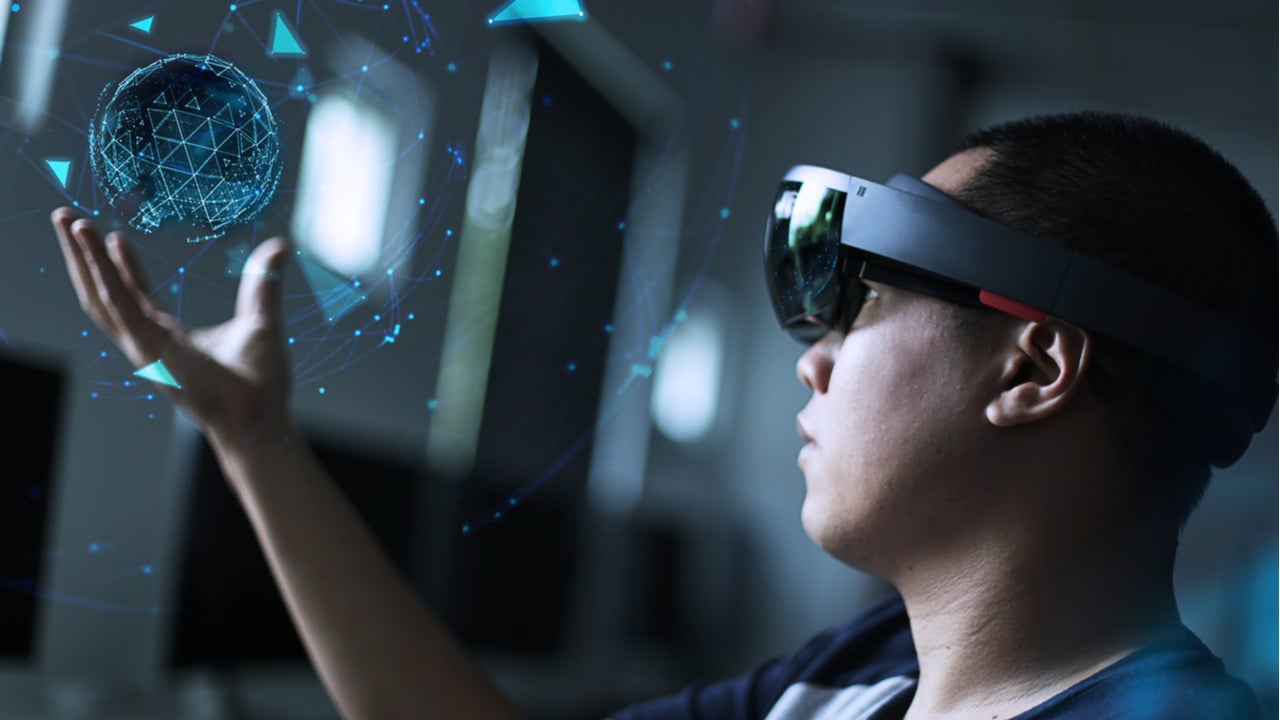The number of emerging use cases of augmented reality (AR) is growing and the technology is beginning to move into the mainstream. AR is expected to disrupt several industries, including retail, logistics, healthcare, law enforcement, defence, and manufacturing.
Listed below are the key technology trends impacting the AR theme, as identified by GlobalData.
Metaverse
The metaverse is a virtual world where users share experiences and interact in real-time within simulated scenarios. Metaverse developers will increasingly focus on augmented reality allowing the user to see the real world overlaid with a layer of digital content. AR-related technologies such as SLAM, facial recognition, and motion tracking will be vital for developing metaverse-based use cases.
Gaming platforms are at the forefront of metaverse development., Epic Games raised $1bn funding in April 2021 led by Sony’s $200m investment after demonstrating its ability to develop a metaverse within Fortnite. Social media-blended gaming platforms, such as ROBLOX and Facebook, and game makers like Niantic, are also investing in the metaverse.
Mobile AR
Mobile AR refers to augmented reality functionalities accessible via apps on mobile devices, particularly smartphones. The existing smartphone ecosystem, consumer comfort with smartphones, and the improving computing capabilities of these devices are major drivers of mobile AR. The lack of self-contained, affordable, and compelling AR-specific hardware also benefits mobile AR. Much of the AR compatibility in the smartphone landscape happens outside of the traditional iOS and Android ecosystems, thanks to social media platforms that support AR, according to ARtillery Intelligence.
ARtillery Intelligence estimates that Facebook’s Spark AR platform was compatible with 1.6 billion devices in 2020, which put it ahead of Apple’s ARKit, ByteDance’s AR Effect Platform, Google’s ARCore, and Snap’s Lens Studio. The number of monthly active users for these platforms, however, is significantly lower than the number of compatible devices, which is primarily due to the current dearth of AR content. AR’s integration into apps such as Google Maps, Instagram, TikTok, and Snapchat, however, will boost awareness and adoption of mobile AR.
How well do you really know your competitors?
Access the most comprehensive Company Profiles on the market, powered by GlobalData. Save hours of research. Gain competitive edge.

Thank you!
Your download email will arrive shortly
Not ready to buy yet? Download a free sample
We are confident about the unique quality of our Company Profiles. However, we want you to make the most beneficial decision for your business, so we offer a free sample that you can download by submitting the below form
By GlobalDataContact lenses
AR-capable contact lenses are in development that could turn AR into a more natural, intuitive, and accessible utility. A combination of voice commands and eye movements would enable the user to view weather and traffic updates or walking directions right in their line of sight without any visible eyewear. Samsung secured an AR contact lens patent in 2016, with Sony moving into the same area in 2017.
WebAR
WebAR allows users to experience AR content through web browsers rather than using a standalone app. In 2020, WebAR was compatible with more than three billion devices, nearly twice the combined installed base of ARKit and ARCore, according to ARtillery Intelligence. 8th Wall, Zappar, and Aircards enable WebAR experiences on browsers such as Chrome, Edge, Safari, and Firefox.
At the time of writing, most WebAR applications are used for marketing campaigns run by companies such as Coca-Cola, Toyota, EE, Sephora, and Universal Pictures. In 2020, for example, Universal Pictures ran a WebAR campaign to promote the movie Trolls World Tour, allowing users to overlay a map of the troll’s kingdom into their real-world environment and access face filters resembling characters from the film.
Artificial intelligence (AI)
AI technologies such as machine learning (ML), conversational platforms, and AI chips power most of today’s AR devices and apps. AR developers use ML to improve the user experience (UX) by continually analysing user activities. Apple’s CoreML and Google’s TensorFlow Lite ML frameworks support ARKit and ARCore, respectively. They allow developers to run ML models to improve object recognition in photos, convert speech to text, and enable gesture recognition. Eye-tracking and facial recognition, fast becoming standard functions across all AR devices, use ML to improve UX.
Virtual assistants such as Apple’s Siri, Amazon’s Alexa, Google’s Assistant, and Microsoft’s Cortana enable the hands-free operation of AR devices, which is critical for some use cases especially in enterprises. Efforts to develop low-power AI chips for AR devices are also underway.
5G
The bandwidth limitations of current telecom networks are a significant factor restricting AR’s growth. Non-AR gaming requires latency of under 100 milliseconds for a satisfactory user experience, while AR gaming requires latencies of less than 20 milliseconds. Thus, 5G’s expected latency of one millisecond should deliver excellent experiences for AR applications, including gaming and streaming of live events. A spike in industry partnerships for AR development has occurred with telcos eager to make the most of 5G.
Cloud
Cloud services are critical enablers of AR, allowing developers to process, store, and analyse their AR content and consumer data. AR content is stored on cloud platforms and made available on-demand as most AR devices come with limited processing and storage capabilities. This approach reduces the need for high-end on-device processing, however, the device’s distance from the remote server and network latency can inhibit the flow of content.
Cloud services offer developers the ability to stream AR content from cloud platforms to end-user devices through low latency 5G networks. Google’s Cloud AR, for example, offloads the computing power needed to display large 3D files to remote servers and edge networks and streams the 3D content to AR devices using Google’s Scene Viewer tool. Most cloud service providers offer AI tools for app developers to analyse user trends and develop products.
The future of work
AR will be a key technology in the future of work, with visualisation involving the use of images or graphics to convey information or communicate messages. Many workers are required to aggregate, analyse, and interpret vast amounts of constantly changing and expanding data.
AR headsets and AR smart glasses are already used to access online environments such as Spatial’s collaboration platform that allows workers to use 3D avatars in a virtual workspace. AR is now being used in industries such as logistics, automotive, and semiconductors for tasks including warehouse management, maintenance and repair, collaboration, and training.
This is an edited extract from the Augmented Reality (AR) – Thematic Research report produced by GlobalData Thematic Research.









Related Company Profiles
Amazon.com Inc
Apple Inc
Google LLC
Microsoft Corp
Sony Group Corp